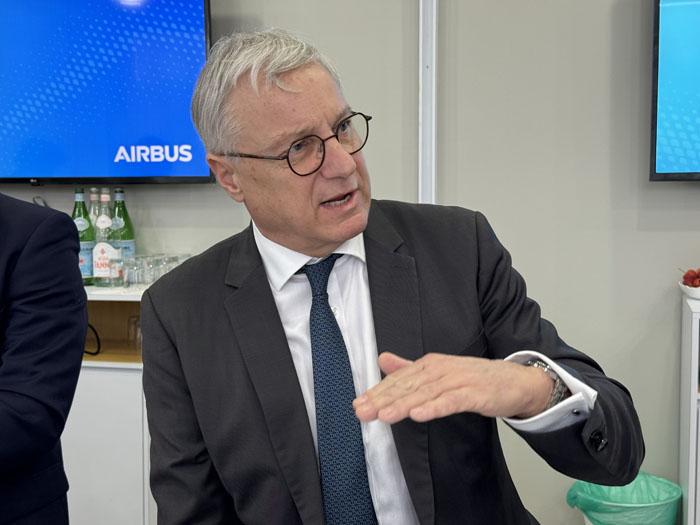
Christian Scherer, recently promoted to CEO of Airbus' Commercial Aircraft division, briefs journalists at Singapore Airshow.
SINGAPORE—Airbus is “considering Comac as a competitor in the future,” but the C919 is “not going to rock the boat in a significant way”, Airbus Commercial CEO Christian Scherer said Feb. 20 at the Singapore Airshow.
The C919 is making its international air show debut in Singapore, with the manufacturer announcing further orders for it from Chinese customers. For Airbus, China is the biggest market in Asia-Pacific. The company is in the process of doubling capacity of its Tianjin A320neo family final assembly line to cater for demand from China and elsewhere.
“The C919 looks a bit like an Airbus narrowbody,” Scherer said at the show looking through a window of the Airbus chalet. The C919 was parked in its vicinity.
In his view, it is “quite legitimate” for China to build its own aerospace industry and “the market is large enough to cater for competition.” Airbus expects Comac to market the aircraft outside of China, although initial operational experience will have to be gained by Chinese airlines. China Eastern currently operates four C919s. “We don’t want to dismiss Comac. It is normal to see competition in a growing industry,” Scherer said.
The Asia-Pacific region is playing a growing role for Airbus’ commercial business. Coming from around one third of global demand, the region will grow to 40% in the coming years, Scherer predicted. Airbus is displaying a Starlux A330-900 and an A350-1000 here at the air show.
Airbus added seven new customers for the A350 in 2023. Scherer expects surging demand for widebodies to continue, particularly in Asia. “There is no reason for the region to slow down.”
However, Airbus recently lost a large campaign for 45 new widebodies at Thai Airways, with Rolls-Royce’s higher engine prices said to be a key factor for the airline to move to GE Aerospace-powered Boeing 787 fleet, marking a significant setback for Airbus. Scherer played down the case, saying that Rolls-Royce’s Trent XWBs are “by all accounts the best widebody engines.” Airbus had a “good relationship with Rolls-Royce,” he added.
In production, Airbus is still facing “many pinch points,” Scherer said. “You cannot point to any one area—there are weak links at every level in the supply chain.” These currently include the supply of steel and other raw materials, cabin equipment, engines and aerostructures. “The ramp-up is paced by suppliers,” he said.
Safran CEO Olivier Andries had stated last week its CFM International is achieving a greater market share for the Leap 1A engine than expected and that its joint venture with GE Aerospace is not targeting a 75% market share on the program. Scherer said that in spite of the higher-than-expected demand for the Leap 1A, Airbus is currently “not constrained by the supply of CFM engines. It could happen in the future but right now I don’t see it.”
Airbus is “addressing the weak links” but is not looking at reorganizing the industrial set-up. That is particularly true of the A220 program which is still largely operating as planned by its former owner Bombardier.





